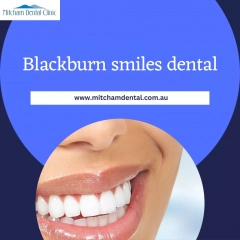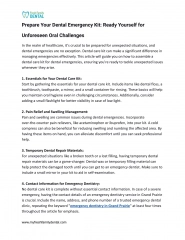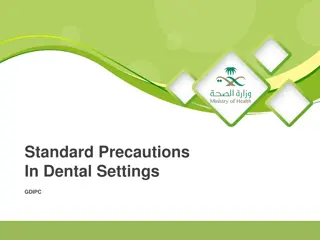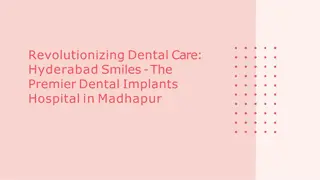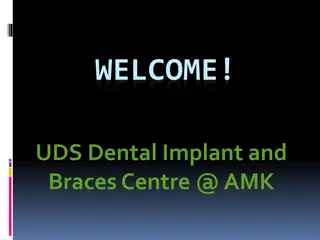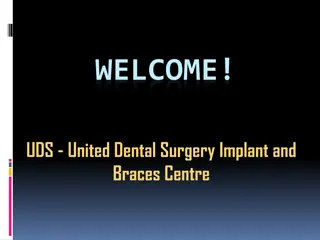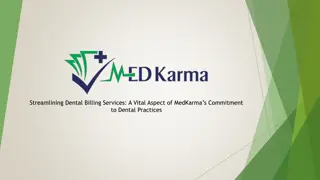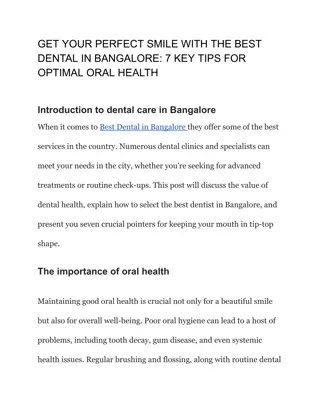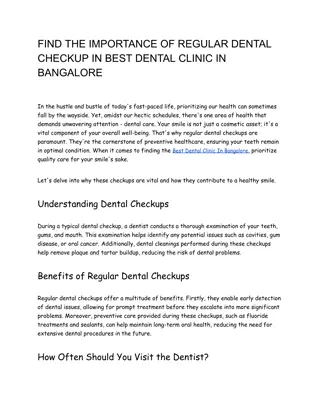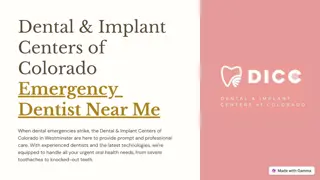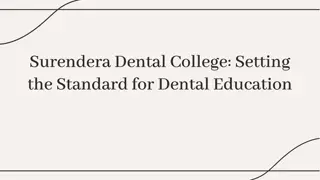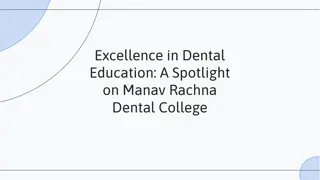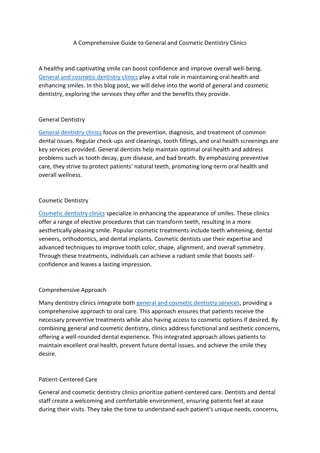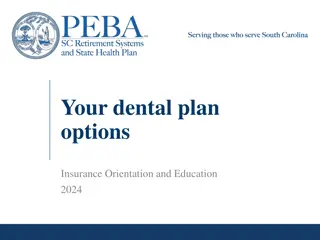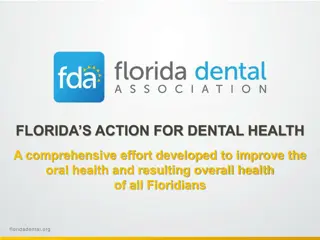Treatment Plan at Rungta College of Dental Sciences
In this detailed presentation by Dr. Sonika Bodhi, the treatment plan at Rungta College of Dental Sciences and Research in Bhilai is outlined, covering specific learning objectives, core areas, introduction, emergency phase, nonsurgical phase, surgical phase, restorative phase, maintenance phase, tooth extraction considerations, and more.
Download Presentation

Please find below an Image/Link to download the presentation.
The content on the website is provided AS IS for your information and personal use only. It may not be sold, licensed, or shared on other websites without obtaining consent from the author.If you encounter any issues during the download, it is possible that the publisher has removed the file from their server.
You are allowed to download the files provided on this website for personal or commercial use, subject to the condition that they are used lawfully. All files are the property of their respective owners.
The content on the website is provided AS IS for your information and personal use only. It may not be sold, licensed, or shared on other websites without obtaining consent from the author.
E N D
Presentation Transcript
RUNGTA COLLEGE OF DENTAL SCIENCES AND RESEARCH,BHILAI TREATMENT PLAN PRESENTED BY: Dr Sonika Bodhi Reader Dept. of Periodontology 1
SPECIFIC LEARNING OBJECTIVES 2 CORE AREAS Introduction Emergency Phase Nonsurgical Phase (Phase I Therapy) Surgical Phase (Phase II Therapy) Restorative Phase (Phase III Therapy) Maintainence Phase (Phase IV Therapy) DOMAIN Affective Cognitive Cognitive CATEGORY Desire to know Must to know Must to know Cognitive Must to know Cognitive Must to know Cognitive Must to know
Contents 3 Introduction Emergency Phase Nonsurgical Phase (Phase I Therapy) Surgical Phase (Phase II Therapy) Restorative Phase (Phase III Therapy) Maintainence Phase ( Phase IV Therapy) Summary
Introduction 4 After the diagnosis and prognosis have been established, the treatment is planned. The treatment plan is the blueprint for case management. It includes all procedures required for the establishment and maintenance of oral health and involves the following decisions:
Teeth to be retained or extracted. 5 Pocket therapy techniques, surgical or nonsurgical, that will be used. The need for occlusal correction, before, during, or after pocket therapy. The use of implant therapy. The need for temporary restorations. Final restorations that will be needed after therapy, and which teeth will be abutments if a fixed prosthesis is used. The need for orthodontic consultation. Endodontic therapy. Decisions regarding esthetic considerations in periodontal therapy. Sequence of therapy.
6 except for emergencies, no treatment should be started until the treatment plan has been established.
Extracting or Preserving a Tooth 7 A tooth should be extracted when any of the following occurs: It is so mobile that function becomes painful. It can cause acute abscesses during therapy. There is no use for it in the overall treatment plan.
A tooth can be retained temporarily, postponing the decision to extract it until after treatment, when any of the following occurs: 8 It maintains posterior stops; the tooth can be removed after treatment when it can be replaced by a prosthesis. It maintains posterior stops and may be functional after implant placement in adjacent areas.
9 In complex cases, interdisciplinary consultation Consideration of occlusal relationships may be in order and may necessitate occlusal adjustment; restorative, prosthetic, and orthodontic procedures; splinting; and correction of bruxism and clamping and clenching habits. Systemic conditions should be taken in conjunction with the patient s physician. Supportive periodontal care
Phases of Periodontal Therapy 11 Treatment of emergencies: Dental or periapical Periodontal Other Extraction of hopeless teeth and provisional replacement if needed (may be postponed to a more convenient time)
Nonsurgical Phase (Phase I Therapy) 12 Plaque control and patient education: Diet control (in patients with rampant caries) Removal of calculus and root planing Correction of restorative and prosthetic irritational factors Excavation of caries and restoration (temporary or final, depending on whether a definitive prognosis for the tooth has been determined and on the location of caries) Antimicrobial therapy (local or systemic)
13 Occlusal therapy Minor orthodontic movement Provisional splinting and prosthesis Evaluation of response to nonsurgical phase Rechecking: Pocket depth and gingival inflammation Plaque and calculus, caries
Surgical Phase (Phase II Therapy) 14 Periodontal therapy, including placement of implants Endodontic therapy Rechecking: Gingival and periodontal conditions
Restorative Phase (Phase III Therapy) 15 Final restorations Fixed and removable prosthodontic appliances
Maintenance Phase (Phase IV Therapy) 16 Periodic rechecking: Plaque and calculus Gingival condition (pockets, inflammation) Occlusion, tooth mobility Other pathologic changes
SUMMARY 17 Treatment plan is a blueprint for case management. A treatment plan is a plan for therapy formulated only after a thorough examination has been completed, diagnosis and prognosis have been determined, and the needs and desires of the patient have been taken into consideration.
REFERENCES 18 Newman MG, Takei HH, Klokkevold PR, Carranza FA. Carranza s clinical periodontology, 10th ed. Saunders Elsevier; 2007. Lindhe J, Lang NP and Karring T. Clinical Periodontology and Implant Dentistry. 6th ed. Oxford (UK): Blackwell Publishing Ltd.; 2015. Newman MG, Takei HH, Klokkevold PR, Carranza FA. Carranza s clinical periodontology, 13th ed. Saunders Elsevier; 2018.


